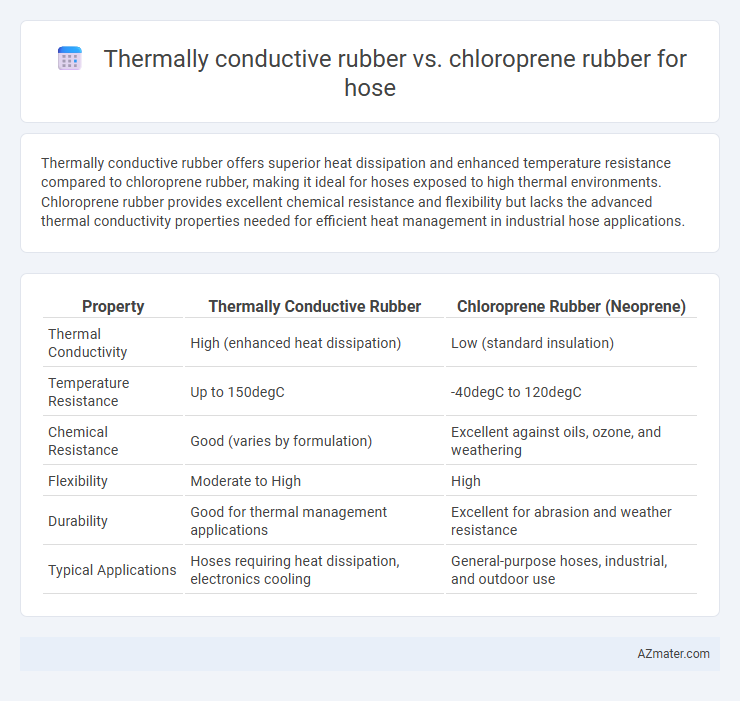Thermally conductive rubber offers superior heat dissipation and enhanced temperature resistance compared to chloroprene rubber, making it ideal for hoses exposed to high thermal environments. Chloroprene rubber provides excellent chemical resistance and flexibility but lacks the advanced thermal conductivity properties needed for efficient heat management in industrial hose applications.
Table of Comparison
| Property | Thermally Conductive Rubber | Chloroprene Rubber (Neoprene) |
|---|---|---|
| Thermal Conductivity | High (enhanced heat dissipation) | Low (standard insulation) |
| Temperature Resistance | Up to 150degC | -40degC to 120degC |
| Chemical Resistance | Good (varies by formulation) | Excellent against oils, ozone, and weathering |
| Flexibility | Moderate to High | High |
| Durability | Good for thermal management applications | Excellent for abrasion and weather resistance |
| Typical Applications | Hoses requiring heat dissipation, electronics cooling | General-purpose hoses, industrial, and outdoor use |
Introduction to Hose Material Selection
Thermally conductive rubber offers superior heat dissipation properties compared to chloroprene rubber, making it ideal for hoses exposed to high-temperature environments or requiring efficient thermal management. Chloroprene rubber, also known as Neoprene, provides excellent chemical resistance, flexibility, and weather durability, suitable for general-purpose hoses in moderate temperature ranges. Selecting hose materials requires balancing thermal conductivity, resistance to environmental conditions, and mechanical flexibility based on specific application demands.
Overview of Thermally Conductive Rubber
Thermally conductive rubber offers enhanced heat dissipation properties compared to traditional chloroprene rubber, making it ideal for applications requiring efficient thermal management. This material incorporates conductive fillers such as graphite or metal oxides, significantly improving its thermal conductivity while maintaining flexibility and durability. Its ability to withstand high temperatures and handle thermal cycling makes it a superior choice for hoses used in automotive, industrial, and electronic cooling systems.
Key Properties of Chloroprene Rubber
Chloroprene rubber, also known as neoprene, offers excellent chemical resistance, flexibility, and weatherability, making it ideal for hose applications exposed to oils, solvents, and UV light. Its superior tensile strength and abrasion resistance ensure durability under mechanical stress, while maintaining good elasticity across a wide temperature range from -40degC to 120degC. Compared to thermally conductive rubber, chloroprene excels in resilience and environmental stability but lacks enhanced heat dissipation properties.
Thermal Conductivity: Performance Comparison
Thermally conductive rubber exhibits significantly higher thermal conductivity, typically ranging from 1 to 5 W/m*K, compared to chloroprene rubber's lower values around 0.2 W/m*K, enabling more efficient heat dissipation in hose applications. This enhanced thermal performance reduces the risk of overheating and improves durability in high-temperature environments, making thermally conductive rubber ideal for demanding industrial uses. Chloroprene rubber, while offering good chemical resistance and flexibility, is less effective at conducting heat, limiting its application in scenarios requiring rapid thermal management.
Mechanical Strength and Durability
Thermally conductive rubber for hoses exhibits superior mechanical strength and enhanced durability due to its ability to dissipate heat effectively, reducing thermal degradation and extending service life. Chloroprene rubber offers good mechanical properties and resistance to weathering, ozone, and chemicals but may suffer from reduced durability under high thermal stress. Choosing thermally conductive rubber improves hose longevity in high-temperature applications by maintaining structural integrity and minimizing breakdown from thermal cycling.
Flexibility and Handling in Hose Applications
Thermally conductive rubber offers superior flexibility and enhanced heat dissipation, making it ideal for hose applications requiring efficient thermal management and easier handling in tight spaces. Chloroprene rubber, while providing good chemical resistance and durability, generally exhibits less flexibility compared to thermally conductive variants, potentially limiting hose maneuverability. Selecting thermally conductive rubber improves hose performance in dynamic environments by balancing pliability with thermal conductivity for better operational reliability.
Resistance to Chemicals and Weathering
Thermally conductive rubber for hoses offers enhanced resistance to a wide range of chemicals and superior weathering durability compared to chloroprene rubber, making it ideal for harsh industrial environments. Chloroprene rubber provides good general chemical resistance and moderate weathering resistance but may degrade faster when exposed to strong solvents or prolonged UV radiation. Selecting thermally conductive rubber improves hose longevity and reliability in chemically aggressive and outdoor applications, optimizing performance under extreme conditions.
Cost Considerations and Availability
Thermally conductive rubber hoses typically incur higher initial costs due to specialized fillers enhancing heat dissipation, impacting budget-sensitive projects. Chloroprene rubber hoses offer greater availability and lower pricing, benefiting applications where thermal conductivity is less critical. Availability of chloroprene rubber is widespread globally, whereas thermally conductive variants may face limited suppliers and extended lead times, influencing procurement decisions.
Application Suitability and Industry Standards
Thermally conductive rubber offers superior heat dissipation properties, making it ideal for applications requiring efficient thermal management such as electronics cooling and automotive thermal interfaces. Chloroprene rubber, known for its excellent chemical resistance, weather durability, and flexibility, is widely used in industrial hoses exposed to oils, acids, and ozone. Industry standards like ASTM D2000 for rubber materials establish performance criteria where thermally conductive rubber meets specific thermal conductivity requirements, while chloroprene rubber complies with standards for chemical resistance and mechanical robustness in industrial hose manufacturing.
Conclusion: Choosing the Right Rubber for Hoses
Thermally conductive rubber offers superior heat dissipation, making it ideal for hoses exposed to high temperatures or requiring efficient thermal management. Chloroprene rubber provides excellent chemical resistance, flexibility, and durability, suitable for general-purpose hoses in automotive, industrial, and marine applications. Selecting the right rubber depends on the specific hose requirements, with thermally conductive rubber favored for heat-critical environments and chloroprene preferred for versatile, durable performance.

Infographic: Thermally conductive rubber vs Chloroprene rubber for Hose
 azmater.com
azmater.com